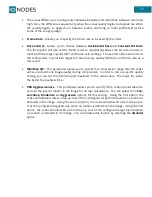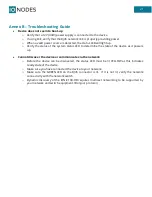
19
Annex A
–
Configuration Parameter Reference
1.
Video Input Configuration
•
Audio Association
–
This parameter allows you to associate a specific audio input with this
video input.
•
Enabled
–
This parameter allows you to enable or disable a video input.
•
Wide Conversion
–
This parameter tell what to do when passing from a resolution with an
aspect ration of 16:9 to a re
solution with an aspect ration of 4:3. It can be set to “stretch”,
to
rescale the image to the new resolution without loosing any part of the image. It can also
be set to “crop”, where the aspect ration of the image if keep, droping
pixels at each side or
at the top and bottom.
2.
Video Codec Configuration (H.264 & JPEG)
•
Enabled
–
This parameter allows you to enable or disable a video codec.
•
Resolution
–
Allows you to select the video resolution of encoded images.
•
Target Bit Rate
–
Allows you to select the target bit rate to be used by the codec.
•
Enabled
–
This parameter allows you to enable or disable a video codec.
3.
JPEG Specific Codec Configuration
•
Frame Rate
–
Allows you to specify the frame rate to be used by the codec. In JPEG, this
frame rate will be guaranteed regardless of the rate control setting.
•
Quality
–
Allows you to select a value for quality of JPEG compression from 0 to 100. The
higher the value, the better the quality. This setting is only applicable if the Rate Control
parameter is set to Fixed Quality.
•
Rate Control
–
Allows you to choose between
Variable Bit Rate
and
Fixed Quality
. The
first option will instruct the JPEG codec to prioritize bit rate over quality. The second option
will instruct the JPEG codec to use the specified quality setting and vary bit rate accordingly.
4.
H.264 Specific Codec Configuration
•
Profile
–
Allows you to select the H.264 codec profile from
Baseline
,
Main
and
High
pro-
files. Baseline: does not contain all the optimization that enhances the visual quality of the
video. This profile is the one requiring the least video processing power. Main: Adds in-
loop deblocking filter and CABAC encoding. Requires more processing power to encode
and decode. High: Adaptive 8x8 or 4x4 transforms on the image.





































